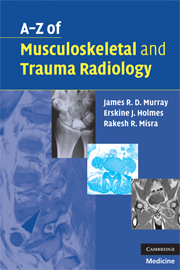Book contents
- Frontmatter
- Contents
- Acknowledgements
- Preface
- List of abbreviations
- Section I Musculoskeletal radiology
- Section II Trauma radiology
- ATLS – Advanced Trauma Life Support
- Acetabular fractures
- Aortic rupture
- Cervical spine injury
- Flail chest
- Haemothorax
- Open fractures
- Pelvic fracture
- Peri-physeal injury
- Pneumothorax
- Rib/sternal fracture
- Skull fracture
- Thoraco-lumbar spine fractures
- Acromioclavicular joint injury
- Carpal dislocation and instability
- Clavicular fractures
- Elbow injuries and distal humeral fractures
- Hand injuries – general principles
- Hand injuries – specific examples
- Thumb metacarpal fractures
- Humerus fracture – proximal fractures
- Humerus fracture – shaft fractures
- Humerus fracture – supracondylar fractures – paediatric
- Radius fracture – head of radius fractures
- Radius fracture – shaft fractures
- Galeazzi fracture dislocation
- Radius fracture – distal radial fractures
- Related wrist fractures
- Scaphoid fracture
- Scapular fracture
- Shoulder dislocation
- Ulna fracture – proximal and olecranon fractures
- Ulna fracture – shaft fractures
- Monteggia fracture dislocation
- Accessory ossicles of the foot
- Ankle fractures
- Bone bruising
- Calcaneal (Os calcis) fractures
- Femoral neck fracture
- Femoral shaft fracture
- Femoral supracondylar fracture
- Hip dislocation – traumatic
- Knee soft-tissue injury
- Metatarsal fractures – commonly fifth MT base
- Patella fracture
- Tibial-plateau fracture
- Tibial-shaft fractures
- Tibial-plafond (Pilon) fractures
- Talus fractures/dislocations
Galeazzi fracture dislocation
from Section II - Trauma radiology
Published online by Cambridge University Press: 22 August 2009
- Frontmatter
- Contents
- Acknowledgements
- Preface
- List of abbreviations
- Section I Musculoskeletal radiology
- Section II Trauma radiology
- ATLS – Advanced Trauma Life Support
- Acetabular fractures
- Aortic rupture
- Cervical spine injury
- Flail chest
- Haemothorax
- Open fractures
- Pelvic fracture
- Peri-physeal injury
- Pneumothorax
- Rib/sternal fracture
- Skull fracture
- Thoraco-lumbar spine fractures
- Acromioclavicular joint injury
- Carpal dislocation and instability
- Clavicular fractures
- Elbow injuries and distal humeral fractures
- Hand injuries – general principles
- Hand injuries – specific examples
- Thumb metacarpal fractures
- Humerus fracture – proximal fractures
- Humerus fracture – shaft fractures
- Humerus fracture – supracondylar fractures – paediatric
- Radius fracture – head of radius fractures
- Radius fracture – shaft fractures
- Galeazzi fracture dislocation
- Radius fracture – distal radial fractures
- Related wrist fractures
- Scaphoid fracture
- Scapular fracture
- Shoulder dislocation
- Ulna fracture – proximal and olecranon fractures
- Ulna fracture – shaft fractures
- Monteggia fracture dislocation
- Accessory ossicles of the foot
- Ankle fractures
- Bone bruising
- Calcaneal (Os calcis) fractures
- Femoral neck fracture
- Femoral shaft fracture
- Femoral supracondylar fracture
- Hip dislocation – traumatic
- Knee soft-tissue injury
- Metatarsal fractures – commonly fifth MT base
- Patella fracture
- Tibial-plateau fracture
- Tibial-shaft fractures
- Tibial-plafond (Pilon) fractures
- Talus fractures/dislocations
Summary
Characteristics
Defined as a fracture of the radius with associated dislocation of the distal radio-ulnar joint.
Relatively rare fracture occurring in approximately 1 in 14 forearm fractures.
Occurs in falls onto the outstretched extended hand in which the forearm is forcibly pronated.
As with Monteggia fractures, it may occur secondary to a direct blow.
Clinical features
The patient will complain of pain and be reluctant to move the forearm or wrist.
Obvious deformity at the site of radial fracture may be apparent.
Tenderness ± fracture crepitus along the distal radius will be present.
On comparison with the unaffected side, the ulnar head will be prominent with associated soft-tissue swelling.
Radiological features
Obtain AP and true lateral views of the forearm including the wrist.
The radius will commonly be fractured at the junction of middle and distal thirds.
The radius will often appear shortened.
Carefully assess the distal radioulnar joint (DRUJ) for widening.
On the lateral view, the head of the ulna will be displaced dorsally.
Dorsal angulation of the distal radial fragment (apex volar) most likely.
Ulna styloid fractures are common and act as a marker for distal radioulnar joint disruption.
A useful way of remembering this type of forearm fracture is with the acronym ‘GFR’ – Galeazzi Fractured Radius.
Management
ABCs, analgesia and immobilisation initially.
In adults likely to require ORIF of the radial fracture, which normally corrects the DRUJ abnormality.
In children, closed reduction under GA will usually suffice, but careful follow up with true lateral radiographs of the wrist are required.
With late missed injuries, the DRUJ needs stabilisation – such as the Suave–Kapandji procedure – distal ulna osteotomy, partial ulna excision and arthrodesis of the ulnar styloid to the distal radius.
- Type
- Chapter
- Information
- A-Z of Musculoskeletal and Trauma Radiology , pp. 264 - 265Publisher: Cambridge University PressPrint publication year: 2008



